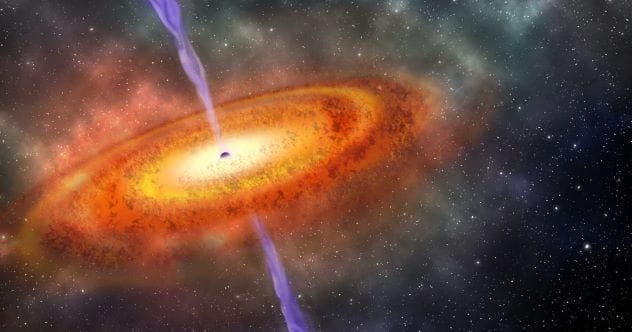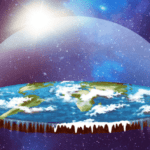Ever gazed at the night sky and wondered about its deepest, oldest secrets? The universe is an incredible 13.77 billion years old, a mind-boggling expanse of time. Thanks to the constant speed of light, we can peek into its infancy, observing cosmic wonders as they were billions of years ago. Prepare to journey back to the dawn of everything as we unveil ten astonishingly ancient cosmic discoveries that will change how you see the cosmos!
10. A Mindbendingly Gigantic and Old Quasar
Meet quasar J0313-1806, a true giant from the early universe. Located an astounding 13.03 billion light-years away, this quasar shines from a time when the universe was less than 5% of its current age. At its heart lies a black hole already boasting 1.6 billion times the mass of our Sun. That’s an incredible size for such an early cosmic object!
This quasar wasn’t just sitting quietly. It was actively spewing out super-hot gasses at one-fifth the speed of light. Its immense energy was also shaping its surroundings, as astronomers have noticed intense star formation in its host galaxy. The black hole’s rapid growth is a puzzle. It’s too massive to have formed from collapsing stars or star clusters in such a short time. Scientists think it might have skipped that step, forming directly from massive clouds of cold hydrogen gas. If so, it would have been born as a hefty baby black hole with the mass of 10,000 suns.
9. A Galaxy That Seemingly Skipped Billions of Years of Evolution
Sometimes, astronomers find objects that make them rethink everything. Galaxy ALMA J081740.86+135138.2 is one such discovery. It’s over 12 billion light-years away, meaning we see it as it was very early in the universe’s history. Yet, it looks surprisingly mature and orderly for its age.
Back then, when the universe was less than two billion years old, about 90% of young galaxies were messy, chaotic collections of gas and dust. But this particular galaxy already had a well-formed rotating disk and was about the same size as our Milky Way, stretching 100,000 light-years across. It also packed a punch, with a mass of 70 to 80 billion suns. Finding such a developed galaxy so early on is unexpected. Usually, it takes billions of years for galaxies to settle down and form these kinds of structures. One idea is that this galaxy grew quickly by channeling cold gas along filaments of dark matter, like a cosmic highway, allowing it to mature ahead of its time.
8. The Early Universe Wasn’t So Empty
Imagine the universe just 300,000 years after the Big Bang. It was filled with a thick, opaque fog of neutral hydrogen gas that blocked all light. This “cosmic dark age” ended when the first stars and galaxies burst into existence, their light ionizing (or electrifying) the hydrogen and clearing the fog.
Scientists can now peer back over 13 billion years to witness this period. Using advanced techniques, they looked for the very first stars, known as Population III stars. While they didn’t find those elusive stars, they discovered something else amazing: a surprising number of small, faint galaxies already existed. These galaxies were up to 100 times fainter and less massive than any previously seen by telescopes like Hubble. This suggests that the first stars might have formed even earlier than we thought. It seems that just 500 million years after the Big Bang, a rich collection of galaxies was already hard at work lighting up the universe.
7. The Oldest Galaxies…Are Right Here
You might think that to find the oldest things in the universe, you’d have to look to its farthest reaches. Surprisingly, some of the most ancient galaxies are practically in our cosmic backyard! Several faint dwarf galaxies orbiting our own Milky Way are over 13 billion years old. These include galaxies like Segue-1, Bootes I, Tucana II, and Ursa Major I.
Their incredible age places them at the very beginning of the universe. This makes them some of the first galaxies ever formed – the pioneers that helped end the cosmic dark ages. These findings support a leading theory called the “Lambda-cold-dark-matter model.” This model suggests that particles of dark matter (whatever they may be) were the driving force behind the universe’s evolution. More than 13 billion years ago, clumps of dark matter used their gravity to pull together ordinary matter, forming the first stars and galaxies.
6. A Solar Graveyard
Our Sun won’t burn forever. In about five billion years, it will run out of fuel, puff up into a red giant, shed its outer layers, and finally settle down as a dense white dwarf star. We can see a glimpse of this future by looking at other stars, like SDSS J122859.93+104032.9, located about 410 light-years away.
This star was once about twice as massive as our Sun. After it died, it shrank to become only 70% of the Sun’s mass. Now, it’s surrounded by a cosmic graveyard – a debris field made from the shattered remains of the planets that once orbited it. Amidst this destruction, astronomers detected something remarkable: a planetary fragment, a heavy metal body that somehow survived its star’s death. This piece was spotted thanks to a stream of gas coming from it. Its exact size is unknown; it could be just a kilometer across or as large as some of the solar system’s biggest asteroids. To withstand the immense gravity of the white dwarf (100,000 times stronger than Earth’s), this fragment is likely an ultra-dense, metallic core of a former planet.
5. The Mysteriously Ancient Galactic Disk
Meet DLA0817g, also known as the Wolfe Disk. This galaxy is a cosmic puzzle because it’s a well-formed rotating disk galaxy, spinning at 170 miles per second, that existed when the universe was only 1.5 billion years old. This discovery has challenged our understanding of how galaxies form.
Astronomers previously thought that galaxies like the Wolfe Disk needed much more time to develop their stable, orderly disks – around 6 billion years, which is nearly half the current age of the universe. Most galaxies from that early era were messy and chaotic, often the result of dramatic collisions. The Wolfe Disk, however, is different. This suggests it might have formed through another process, perhaps by steadily sucking in streams of cool gas, like a giant cosmic vacuum cleaner. This continuous supply of gas would have allowed it to maintain its disk shape and fuel star formation at a rate ten times faster than in our own Milky Way.
4. Quasars Terrorized a Young Universe
By looking deep into space and time, astronomers have found a group of quasars at the very edge of the observable universe, more than 13 billion light-years away. These objects existed in an incredibly early epoch, so early that the universe was largely dust-free. There simply hadn’t been enough time for stars to produce and scatter the heavy elements that form cosmic dust.
Out of 21 ancient quasars detected from this baby universe, two of them, J0005-0006 and J0303-0019, are the first ones ever seen without any surrounding dust. They belong to the most distant population of quasars ever found, already shining brightly less than a billion years after the Big Bang. These ancient cosmic beacons are powered by supermassive black holes, each containing the mass of about 100 million suns. Because they lack dust, astronomers believe these are first-generation quasars, offering a pristine view of these energetic objects from the dawn of time.
3. A Star Nearly As Old As Existence Itself

Astronomers have discovered a star, named 2MASS J18082002–5104378 B, that is an unbelievable 13.5 billion years old. That makes it almost as old as the universe itself! And incredibly, this ancient star is expected to keep burning for trillions of years, a lifespan that dwarfs the current age of the cosmos. Perhaps the biggest surprise is its location: not at the far reaches of space, but relatively close to home, within our own Milky Way galaxy.
Even more surprisingly, it’s found in the “thin disk” of our galaxy, the same galactic neighborhood where our Sun resides. This star, with its rather long name, is so ancient that it could be just one generation removed from the very first stars that ever lit up the universe. These first stars were made almost entirely of hydrogen and helium, with very few heavier elements (metals). Metals were forged later inside stars and in supernova explosions. This ancient star’s composition reflects that early, metal-poor environment.
2. A Timeless Cosmic Relic
Galaxy NGC 1277 is truly special. It’s like a cosmic time capsule, a relic that shows us what galaxies were like in the early universe. This galaxy has remained essentially unchanged for the past 10 billion years! It’s one of over a thousand galaxies in the Perseus cluster, about 240 million light-years away. Finding such a “1-in-1,000” relic relatively close by is unusual, as they are typically found much farther away.
NGC 1277 is packed almost exclusively with old stars, born around 10 billion years ago. These stars once shone brightly blue but have now aged into redder hues, existing in a period of galactic calm. Even though NGC 1277 contains twice as many stars as our Milky Way, it’s only about a quarter of its size, making it incredibly compact. This ancient galaxy faces a quiet future. It’s zooming through space at two million miles per hour, likely too fast to merge with other galaxies or pull in fresh gas needed to form new stars.
1. Amino Acids Form Early, Before the Planets
The presence of amino acids, the building blocks of life, is crucial for the possibility of life elsewhere in the universe. Exciting new research shows that glycine, a simple yet vital amino acid, can form more easily than previously thought. Scientists used to believe that energy, such as ultraviolet (UV) radiation from stars, was needed to create glycine.
However, new studies suggest that UV light isn’t always necessary. Glycine can form through a process called “dark chemistry.” This happens in the cold, dark interstellar clouds where tiny, ice-covered dust particles bump into each other. These collisions cause them to break apart and reassemble into new compounds, including glycine. The most exciting part of this discovery is that glycine and other amino acids might form in these space clouds before the clouds collapse to create stars and planets. This means these essential ingredients for life could be present from the very start of a solar system’s formation and then spread throughout the universe by comets and asteroids, potentially seeding life on other worlds.
These glimpses into the universe’s distant past are more than just fascinating facts; they’re pieces of a colossal puzzle, helping us understand our cosmic origins. From unimaginably old quasars to the building blocks of life forming in primordial clouds, the ancient universe continues to surprise and inspire us. Each discovery pushes the boundaries of our knowledge, reminding us how much more there is to explore in the grand, unfolding story of the cosmos.
What ancient cosmic mystery fascinates you the most? Which of these discoveries blew your mind? Share your thoughts and join the cosmic conversation – leave your comment below!










